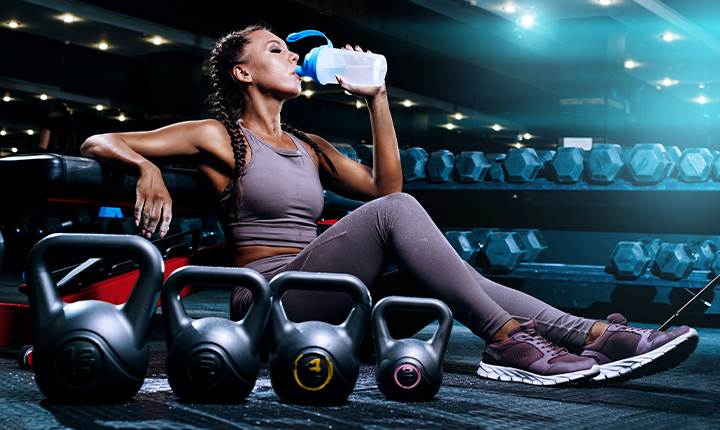Our Blog

How to Figure Out How Much Weight Should You Lift

One common question that people who have never lifted weight ask their trainers is “How much weight should I lift?” When you step into your weight training session for the first time, your over-enthusiasm drives you towards lifting more weight than you should. This restricts you from maintaining the proper form of weight lifting and also increases your chances of getting injured.
First things first, limit your over-enthusiasm, when you enter the gym for the first time. Even if you are lured towards lifting more weight, it is advised that you restrain yourself until you consult with experts. Here, in this article, we are going to share few easy tips for girls and boys know how much weight should they lift.
Tips to know how much weight should you lift
Usually, when we are not aware of anything, we take the trial and error method, where we figure out how much weight should we lift by picking up different weights. But, if you wish to know, how much weight you can handle, and when your body is ready to lift heavier weights, you can follow a common strategy that has been developed by experts. This strategy involves three simple steps –
- Make sure you are doing it right
- Listen to what your body says
- Make sure you keep to the allotted time
Make sure you are doing it right

One common mistake that amateur weight-lifters make is not following the correct posture. When they lift weights, they land up swinging their bodies which makes it easier for them to lift heavier weights. Because, the back muscles help in lifting the weight; however, this is not the correct form.
Ideally, when you are lifting weight, you should focus on the movement of a single muscle, and restrict other muscles from supporting it.
Steps to assess how much weight should you lift
If you wish to assess correctly what is the ideal weight for you, you need to follow the steps mentioned below –
- Make sure you do not lift a weight unsupported.
- Stand straight against the wall, or post, with your back resting on the wall.
- If you wish to develop your bicep, lift the weight focusing on the hand movement, keeping the body still.
This way, you restrict your back muscles from supporting your bicep muscles; you will observe that you are picking up lesser weight than your expectation. Try testing weights maintaining this posture, to figure out how much weight you can handle. It also prevents back pain by avoiding injuries.
Listen to what your body says

Your body is the best indicator that tells you how much weight cans you handles, and it also tells you, when it is time to increase your sets. All you need to do is listen, and pay heed to what your body says.
Steps to test your strength
You must be wondering how to listen to your body right? Here, are a few indications that tell you how to test your strength.
- When you are lifting a particular weight, analyze the strength you require while picking it up. Please remember, that the weight should not be too heavy or too light for you.
- Make sure you lift the weight in sets of 5 to 10 in each hand, to understand whether you would be able to handle it comfortably or not.
How do you know it’s time to increase your capacity
Trying to lift a weight once, does not give you accurate results. It might seem easy for the first time, but if the weight you are lifting is not right for you, then you might feel the strain at a later stage. Therefore, to identify the correct weight lift a particular weight in sets of 5 or 10 in one set.
- When you are testing the weight, ensure you are applying little effort in the first round. If you are applying a lot of effort while lifting the weight, or no effort at all, then you should know that the weight you are lifting is not right for you.
- Once you lift a weight with little effort, and you see the effort is increasing with every set, until a time, you find it difficult to lift the weight; you will know that the weight is perfect for you.
- To identify how many rounds should you do, and when is it time to stop.
It is important that you analyze your capacity. You should stop at a point, where you are not too stressed. For example, if doing 10 rounds of weight lifting tires you completely, and you are not able to pick up the weight, then we suggest, you limit your sets to 7 instead of 10, till the time you get so used to the 7 sets, that you can perform the sets effortlessly. You will know, it is time to increase your rounds of weight lifting when you start feeling effortless.
Make sure you keep to the allotted time

Taking long breaks in between sets increases your potential to lift heavier weights. Because your body is at rest; similarly, if you rush while exercising, you might end up decreasing your capacity to lift a weight.
Therefore, to analyze the correct weight you must keep to the allotted time. Neither do you rush, nor do you rest too much? Make sure you take a break of not less than 30 seconds and no more than 60 seconds in between the sets. This way you can figure out the exact weight you can handle, and the exact rounds of weight lifting you should do in each set. Remember to increase the round of sets when you feel you require little effort to complete the sets.
Conclusion
You can easily figure out how much weight you should lift if you follow a simple three-step strategy.
Firstly, ensure you are lifting the weight in the correct form.
Secondly, your body is the best indicator that tells you, what the correct weight is for you. Make sure you pay heed to the signs it sends you.
And finally, you should not take a break of less than 30 seconds, and more than 60 seconds in between the rounds.
When you can complete your rounds effortlessly, you will know it’s time to increase your sets or increase the weight. If you follow these steps, we are sure you can easily figure out how much weight should you lift during your sessions of weight lifting.







